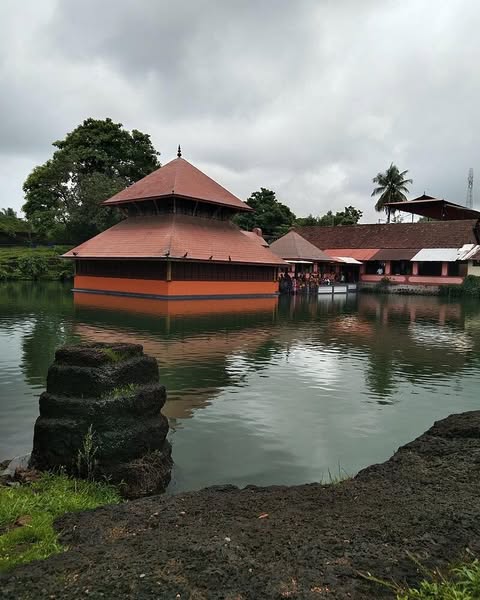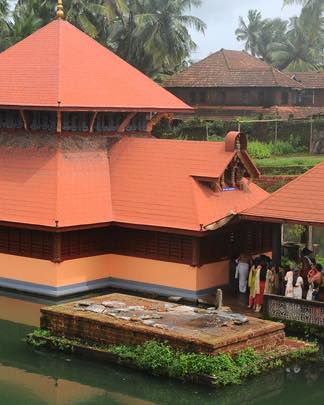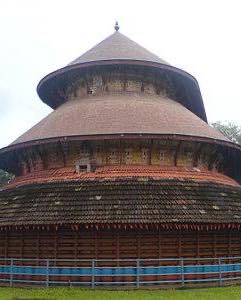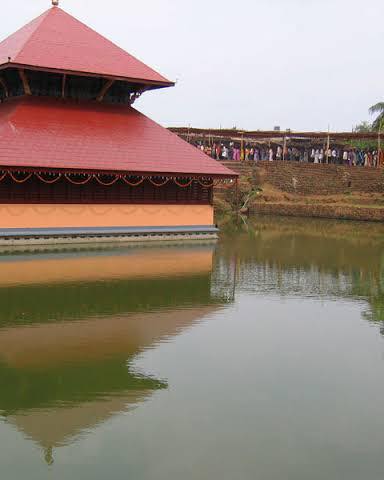Ananthapura Lake Temple location is regarded as one of the 108 Abhimana Kshethrams within the Vaishnavite tradition. According to legend, it is believed to be the original site where Ananthapadmanabha established his presence.

Ananthapadmanabhaswamy Temple, also known as Ananthapura Lake Temple, is a unique Hindu temple situated in the middle of a serene lake in Ananthapura village, approximately 6 km from Kumbla town in Manjeshwaram Taluk, Kasaragod District, Kerala, South India. It is the only lake temple in Kerala and is believed by some traditions to be the original seat (Moolasthanam) of Ananthapadmanabha Swami, the presiding deity of the renowned Padmanabhaswamy Temple in Thiruvananthapuram.
The lake surrounding the sanctum sanctorum spans about 2 acres. A notable feature of the temple is a cave located at the northern corner of the lake. According to local legend, Lord Anantha Padmanabha is said to have journeyed through this cave to Thiruvananthapuram, which is why both places share a similar name, symbolizing their sacred connection. The history of the temple remains largely unknown, except for a few legends. According to one such myth, this is the place where the great Brahmin sage, Divakara Muni Vilwamangalam, performed penance and rituals. One day, Lord Narayana is said to have appeared before him in the form of a radiant young boy.
Captivated by the child’s divine glow, the sage curiously inquired about his identity. The boy replied that he had no parents or home. Moved by compassion, Vilwamangalam allowed him to stay. However, the boy set a condition—if he ever felt humiliated, he would leave immediately. For a while, he served the sage, but soon his mischievous behavior became unbearable. Losing patience, Vilwamangalam reacted harshly, and the boy, feeling insulted, vanished. Before disappearing, he declared that if the sage wished to see him again, he would have to go to Ananthankat, the sacred forest of the serpent god Anantha.
Realizing that the boy was none other than the Lord himself, Vilwamangalam was overcome with deep remorse. Determined to find him, he discovered a cave at the spot where the child had vanished and ventured inside. His journey led him to the sea, and he continued southward until he reached a dense wooded area near the shore. There, he once again saw the divine child, but before his eyes, the boy disappeared into a massive illippa tree (Indian butter tree or Mahua tree). In an instant, the tree collapsed and transformed into the majestic form of Lord Vishnu, reclining on the thousand-hooded serpent, Anantha.
The temple stands out for its unique architectural design, being situated in the middle of a magnificent 302-foot-wide lake. This lake is naturally replenished with pure spring water, ensuring a continuous flow. Scattered around the lake are the ruins of ancient structures, indicating that this site was once part of a grand temple complex. Within the lake itself are the Sreekovil (sanctum sanctorum), Namaskara-mandapam, Thidappalli, and the shrines of Jala-Durga, along with the entrance to a mysterious cave.
Namaskara-mandapam is linked to the eastern rock by a footbridge, which serves as the only access route to the Sreekovil. The principal deity of the temple is Lord Vishnu. A distinctive feature of the temple is that the original idols in the sanctum sanctorum were not made of metal or stone but were crafted from a rare blend of over 70 medicinal materials known as Kadu-Sharkara-Yogam. These idols were replaced in 1972 with ones made of Panchaloha (a sacred five-metal alloy), donated by Kanchi Kamakoti Mathadhipathi Jayendra Saraswathi Thiruvatikal. Efforts are currently underway to reinstall idols made from Kadu-Sharkara-Yogam.
The idol of Lord Vishnu is depicted in a sitting posture over the five-hooded serpent king, Lord Anantha. The temple welcomes visitors of all castes and creeds, emphasizing inclusivity. Recognizing its uniqueness, the District Tourism Promotion Council has initiated plans to preserve the temple and its surroundings. The temple boasts an exquisite collection of wood carvings on the ceilings of the Mandapam, illustrating scenes from the Dashavatara (the ten incarnations of Lord Vishnu). Some of these carvings are beautifully painted.
Navagrahas (nine planets) are depicted in paintings at the Muktha-Mandapam. On either side of the Sreekovil, the Dwara-Palakas (Jaya and Vijaya) are intricately carved in wood, adding to the temple's artistic and spiritual grandeur. Babiya, a famous crocodile that lived in the temple lake, was renowned for being vegetarian. It was believed to have survived solely on temple offerings served twice a week and never harmed a human.
Babiya passed away at the age of 75 on October 9, 2022. In November 2023, in what was considered a miracle, a new crocodile appeared in the lake. Much smaller than Babiya, the newcomer soon displayed similar peaceful behavior, refraining from hunting fish and appearing content with the occasional temple offerings left for it.
അനന്തപുര തടാക ക്ഷേത്രം
കേരളത്തിലെ കാസർഗോഡ് ജില്ലയിലെ ഒരു പ്രസിദ്ധമായ ദേവാലയമാണ് അനന്തപുരം പദ്മനാഭസ്വാമി ക്ഷേത്രം, അതായത് തടാകക്ഷേത്രം. ത്രിമൂർത്തികളിൽ പ്രധാനിയായും സർവ്വേശ്വരനായും പ്രശസ്തനായ ഭഗവാൻ മഹാവിഷ്ണുവാണ് ഇവിടെ പ്രധാന പ്രതിഷ്ഠ. അനന്തശയന ഭാവത്തിലാണ് മഹാവിഷ്ണുവിന്റെ പ്രതിഷ്ഠ. കേരളത്തിലെ ഏക തടാകക്ഷേത്രമായി വിശേഷിപ്പിക്കപ്പെടുന്ന ഈ ദേവാലയം തിരുവനന്തപുരത്തെ അനന്തപദ്മനാഭസ്വാമി ക്ഷേത്രത്തിന്റെ മൂലസ്ഥാനമായാണ് കരുതപ്പെടുന്നത്.
കാസർഗോഡിന്റെ സമീപത്തുള്ള കുമ്പള പട്ടണത്തിൽ നിന്ന് ഏകദേശം 5 കിലോമീറ്റർ അകലെയാണ് ഈ ദേവാലയം സ്ഥിതിചെയ്യുന്നത്. അനന്തപദ്മനാഭസ്വാമി ആദ്യമായി ഇവിടെയാണ് വാസം ചെയ്തതെന്ന് സ്ഥലവാസികൾ വിശ്വസിക്കുന്നു. ക്ഷേത്രത്തിലെ മഹാവിഷ്ണുവിന്റെ വിഗ്രഹം കടുശർക്കരയോഗം എന്ന പുരാതന ശില്പകലാശൈലിയിലാണ് നിർമിച്ചിരിക്കുന്നത്.
മനോഹരമായ ഒരു തടാകത്തിന്റെ മധ്യേ, സവിശേഷമായ വാസ്തുശില്പകലയിൽ നിർമ്മിതമായ ഈ ക്ഷേത്രം ഒരു ദൃശ്യവിസ്മയമാണ്. കൂടാതെ, ഈ തടാകത്തിൽ ഒരു പ്രായമേറിയ മുതലയും ജീവിക്കുന്നു, ഇത് വിശ്വാസികളും സന്ദർശകരും ഏറെ ആരാധിക്കുന്ന ഒരു സവിശേഷതയാണ്. കാസർഗോഡ് ജില്ലാ ആസ്ഥാനത്തുനിന്ന് 13 കിലോമീറ്റർ അകലെ, കുമ്പളയ്ക്കു സമീപമുള്ള അനന്തപുരം ഗ്രാമത്തിലാണ് അനന്തപദ്മനാഭസ്വാമി ക്ഷേത്രം സ്ഥിതി ചെയ്യുന്നത്, ഇത് എത്തിച്ചേരാൻ ഏകദേശം 26 മിനിറ്റ് സമയം വേണ്ടിവരും.
കാസർഗോഡിൽ നിന്ന് ക്ഷേത്രത്തിലേക്ക് ബസ്, ടാക്സി തുടങ്ങിയ യാത്രാസൗകര്യങ്ങൾ ലഭ്യമാണ്, അതേസമയം വിദൂര മേഖലകളിൽ നിന്നെത്തുന്നവർക്ക് ക്ഷേത്രത്തിനുമുന്പായി താമസ സൗകര്യവും ഒരുക്കിയിരിക്കുന്നു. തെക്കുനിന്ന് വരുന്നവർക്ക് കാസർഗോഡിൽ നിന്ന് സീതാംഗോളി വഴി മായിപ്പാടി ശിവാജി നഗറിൽ നിന്നും ഇടത്തേക്ക് 2 കിലോമീറ്റർ സഞ്ചരിച്ചാൽ എളുപ്പത്തിൽ ക്ഷേത്രത്തിലേക്ക് എത്താനാകും. ക്ഷേത്രത്തിന് സമീപം അനന്തരമായ അനന്തരപുരം കുന്ന് സ്ഥിതിചെയ്യുന്നു.
അതേസമയം, ഏറ്റവും അടുത്ത റെയിൽവേ സ്റ്റേഷൻ കുമ്പളയാണ് (5 കിലോമീറ്റർ അകലം), ഇവിടെ മംഗലാപുരം-കാസർഗോഡ് പാതയിൽ ഓടുന്ന പാസഞ്ചർ, മെമു ട്രെയിനുകൾ മാത്രമേ നിർത്തൂ, എന്നാൽ പ്രധാന റെയിൽവേ സ്റ്റേഷൻ കാസർഗോഡാണ്. പണ്ടുമുതലേ ഈ തടാകത്തിൽ കണ്ടുവരുന്ന മുതലയെ ബ്രിട്ടീഷുകാരൻ വെടിവച്ചു കൊന്നെങ്കിലും പിന്നീട് അതേ തടാകത്തിൽ തനിയെ പ്രത്യക്ഷപ്പെട്ട ബബിയ, നിരുപദ്രവകാരിയായിരുന്നു.
ക്ഷേത്രത്തിലെ പൂജാരിമാർ സാക്ഷ്യപ്പെടുത്തുന്നതുപോലെ, ബബിയയുടെ ആഹാരം ക്ഷേത്രത്തിലെ നിവേദ്യങ്ങളായിരുന്നു. 2022 ഒക്ടോബറിൽ ബബിയ മരണപ്പെട്ടതോടെ, ക്ഷേത്രത്തിന്റെ ഒരു അതിമനോഹരമായ വിശേഷം അന്ത്യമായെങ്കിലും, 2023 നവംബറിൽ അതേ തടാകത്തിൽ മറ്റൊരു മുതലയെ പ്രത്യക്ഷപ്പെട്ടതായി അറിയിക്കപ്പെടുന്നു.
Address:
Ananthapura,
Kumbla (Kumble),
Kerala 671321



